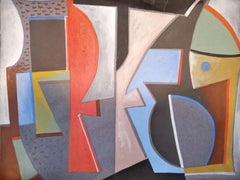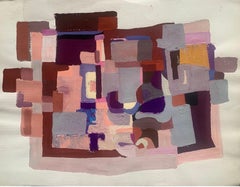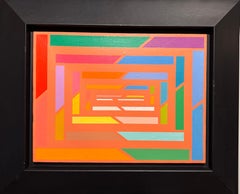Piero Dorazio Abstract Paintings
Italian, 1927-2005
Piero Dorazio (Rome, June 29, 1927 - Perugia, May 17, 2005) was an Italian painter. His work was related to color field painting, lyrical abstraction and other forms of abstract art.
Dorazio was born in Rome. His father was a civil servant, while his mother was interested in history and art. Dorazio attended Julius Caesar Lyceum (high school) in Rome. The family fled to their homeland province of Abruzzo in 1943. After the war, Dorazio worked briefly as a translator for the British Army and then studied architecture at the University of Rome.
He was influenced by futurists such as Gino Severini, Antonio Corpora, Enrico Prampolini, and Giacomo Balla, attracting him to painting. An aversion to their right-wing views pushed him to align instead with left-leaning artists like Renato Guttuso. Along with Pietro Consagra, Achille Perilli, and Giulio Turcato, he helped formulate a manifesto and establish a group of abstract artists in 1947 called Forma I. Although imbued with socialist leanings, the group did not follow the realist social commentary furthered by Guttuso but proposed to reclaim abstraction from Futurism. In 1947 Dorazio won a prize and a stipend from the French government to study at the École des Beaux-Arts of Paris.
Dorazio, along with artists Mino Perilli and Guerrini, helped found L'Age d'Or in 1950. It was a bookstore/gallery space dedicated to abstract art. In 1952, he promoted the foundation Origin with Alberto Burri, Ettore Colla and others, and edited the magazine Arti Visive. As a representative of Italy, in 1953 he traveled for the first time to the United States to participate in the International Summer Seminar at Harvard University. That fall, he moved to New York City and stayed through 1954. In October 1953, Dorazio had his first solo exhibition at George Wittenborn's One-Wall Gallery.
He published La Fantasia Dell-Arte Nella Vita Moderna" in 1955, a review of modern art in Italy. Regarding this book, reviewer Christopher Masters states that Dorazio advanced his belief, perhaps with a surfeit of optimism, that "abstract art could change the world... That just as science and technology were destroying the barriers between different cultures, so the new 'universal style' would lead to a 'universal civilisation'."
He was invited to teach at the Graduate School of Fine Arts program at the University of Pennsylvania School of Design in 1959. He taught painting there for one semester each year from 1960 to 1969, splitting his time between the United States and Italy. In 1970 he returned to live and work full-time in Rome. In 1974 he moved his studio from Rome to Umbria, near Todi. Peter Iden, founding director of the Museum für Moderne Kunst Frankfurt from 1978-1987, acquired three works by Dorazio from 1981 to 1983 (Oracolo, 1959; Blue Hearttrap, 1961; Stridente, 1982-83) for the museum collection.to
1
Overall Width
to
Overall Height
to
1
1
1
1
1
1
1
1
42
666
627
362
342
1
Artist: Piero Dorazio
Italian Abstract Work on Paper Color Field Non-Objective European Mid-Century
By Piero Dorazio
Located in New York, NY
Italian Modern Abstract Work on Paper Color Field Non-Objective European Mid-Century - "Gonage"
Dorazio completed "Gonage" in 1949 when just after the artist had been awarded a stipend by the French government and admission to the Academy Beaux Arts. There he met George Braque who became great friends but also an influence on Dorazio, of which "Gonage" is a living testament.
"Gonage" actual size of the drawing measures 12 x 9 1/2 inches. It is signed on the lower right. The work is affixed to a 19 x 15 inch board which includes the artist's signature and date. There is a torn table on the lower left entitling the piece "Gonage".
Provenance follows this piece as a gift in 1950 to the artist-colleague Luigi Lucioni, who then gifted it in 1955 to his friend, the uncle of the current owner who has owned the work since 1988.
Bio
Born in Italy, Piero Dorazio studied architecture in Rome. At the same time his first abstract works were executed. In 1947 he received a scholarship from the Ecole Nationale Supérieure des Beaux Arts in Paris, where he contacted Modern artists, who lived in Paris. He founded the galleries "Age d'Or" in Florence and Rome to represent avant-garde arts in Italy.
During a one year stay in the USA he got acquainted with leading artists of Abstract Expressionism such as Marc Rothko...
Category
1940s Abstract Piero Dorazio Abstract Paintings
Materials
Gouache, Board
Related Items
Abstract Geometric Composition. Second half of the 20th century
Located in Firenze, IT
Abstract Geometric Composition
Date: Second half of the 20th century
Medium: Gouache on paper
Dimensions: H 50 cm x W 65 cm approx.
Description: Modular geometric structure with ove...
Category
Late 20th Century Abstract Geometric Piero Dorazio Abstract Paintings
Materials
Paper, Gouache
$200 Sale Price
20% Off
H 19.69 in W 25.6 in
Composition with Circles II
By James Pichette
Located in London, GB
'Composition with Circles II', gouache on art paper, by James Pichette. A dynamic, lively abstract composition by an artist known for such stunning, viv...
Category
1970s Abstract Piero Dorazio Abstract Paintings
Materials
Paper, Gouache
Intersecting Magic Square
By Charmion von Wiegand
Located in New York, NY
Charmion von Wiegand
Intersecting Magic Square, ca. 1963
Gouache on paperboard
Signed and titled on the back of the artwork. The signature shown on the frame back is a photo of the actual signature on the artwork itself.
Frame Included: elegantly floated and framed in hand made white wood museum frame with UV plexiglass
This work is signed and titled on the back of the artwork itself. The signature shown on the back of the frame is a photo of the actual signature, since the actual pencil signature and title is on the artwork itself, which can't be seen within the frame
Measurements:
Frame:
21 x 17 x 1.5 inches
Artwork:
18 x 14.25 inches
The Estate of the celebrated artist Charmion Von Wiegand has been represented exclusively by Michael Rosenfeld...
Category
1960s Abstract Geometric Piero Dorazio Abstract Paintings
Materials
Gouache, Handmade Paper, Mixed Media, Pencil
Study #26, 1960s Gouache painting Signed Framed Pace & Hudson Gallery provenance
By Jack Youngerman
Located in New York, NY
Jack Youngerman
Untitled Study #26, 1967
Gouache painting on paper (with original JL Hudson and PACE Gallery labels)
Hand signed and dated '67 on the front; J.L. Hudson Gallery Label on Verso.
Unique Abstract Expressionist work on paper
Frame included
Framed
Measurements:
Framed:
15 inches by 15 inches by 1.5 inch
Artwork:
7.75 inches by 7.5 inches
Provenance
From the estate of Anne Markley Spivak
J. L. Hudson Gallery Label affixed to verso (back).
The J.L. Hudson Gallery, Detroit, Michigan
This 1967 unique, signed gouache painting by renowned abstract expressionist painter Jack Youngerman was acquired from the estate of Anne Markley Spivak. It is held in the original vintage metal frame with the original J.L. Hudson Gallery label, as well as the PACE gallery label on the verso
The artwork has been newly loated and framed in a museum quality white wood frame; the original labels from the original back board have been affixed to the back to preserve provenance.
Jack Youngerman Biography
Jack Youngerman was born in St. Louis, Missouri on March 25, 1926. He moved to Louisville, Kentucky in 1929 and studied at the University of Missouri, Columbia from 1944 to 1946 under a wartime navy training program. He graduated from the University of North Carolina Chapel Hill in 1947 and, that same year, he returned to Missouri to finish his Bachelor’s degree in Journalism before moving to Paris on a G.I. scholarship.
In Paris, Youngerman enrolled at the Ecole des Beaux-Arts, studying drawing with Jean Souverbie. He explored Paris, taking in the cathedrals, museums, and history in order to grasp a greater sense of art history. He also traveled to the Netherlands, Spain, Belgium, Italy, and Greece on fine art excursions.
In 1948, Youngerman became friends with Ellsworth Kelly, Eduardo Paolozzi, and Cesar – fellow students at Ecole des Beaux-Arts. He married Delphine Seyrig in 1950, and later that year he had his first group exhibition at Galerie Maeght in Paris. He visited the studios of Constantín Brancusi and Jean Arp and became heavily influenced by the organic forms present in their work. He also met artist Alexander Calder through his father-in-law, Henri Seyrig, and experimental filmmaker and artist, Robert Breer...
Category
1960s Abstract Expressionist Piero Dorazio Abstract Paintings
Materials
Gouache
$15,000
H 15 in W 15 in D 1.5 in
Dinosaur Me & Baby
By Erez Yardeni
Located in London, GB
'Dinosaur Me & Baby' abstract composition, mixed media on soft board, Japanese ink, oil, pencil and gouache by Erez Yardeni (2018). The scribblings of a c...
Category
2010s Abstract Piero Dorazio Abstract Paintings
Materials
Ink, Oil, Gouache, Board, Pencil
French Expressionist Abstract Original Painting Artists Studio Provenance
Located in Cirencester, Gloucestershire
Abstract Expressionist Composition
by Jacques COULAIS (1955-2011)
gouache painting on paper/ card
unframed: 10.75 x 8.25 inches
condition: very good and impressive
provenance: all th...
Category
20th Century Abstract Expressionist Piero Dorazio Abstract Paintings
Materials
Gouache
Jacques Coulais (1955-2011)French Expressionist Abstract Original Painting Artists Studio Provenance
$429 Sale Price
30% Off
H 10.75 in W 8.25 in
Untitled
By Erez Yardeni
Located in London, GB
'Untitled' abstract composition, mixed media on soft board, Japanese ink, oil, pencil and gouache by Erez Yardeni (2018). Beautifully balanced, stunningly...
Category
2010s Abstract Piero Dorazio Abstract Paintings
Materials
Ink, Oil, Gouache, Board, Pencil
Composition in Orange and Red
By James Pichette
Located in London, GB
'Composition in Orange and Red', gouache on paper, by James Pichette (circa 1970s). A dynamic, lively abstract composition by an artist known for such s...
Category
1970s Abstract Piero Dorazio Abstract Paintings
Materials
Paper, Gouache
Provence Abstract mid 20th Century Painting
By Louis Bellon
Located in Cirencester, Gloucestershire
Provence Abstract
by Louis Bellon (French 1908-1998)
Initialled lower right
gouache painting on paper, unframed
measurements: 9.5 x 14 inches (overall sheet measures 12.5 x 17.5 inc...
Category
Mid-20th Century Abstract Piero Dorazio Abstract Paintings
Materials
Gouache
$598 Sale Price
30% Off
H 9.5 in W 14 in
Composition with Circles
By James Pichette
Located in London, GB
'Composition with Circles', gouache on paper, by James Pichette (circa 1970s). A dynamic, lively abstract composition by an artist known for such stunni...
Category
1970s Abstract Piero Dorazio Abstract Paintings
Materials
Paper, Gouache
French Futurist Abstract Figure Mid 20th Century Signed Painting
By Louis Bellon
Located in Cirencester, Gloucestershire
Futurist Abstract Figure
by Louis Bellon (French 1908-1998)
Signed lower right
gouache painting on paper, unframed
measurements: 12 x 6 inches (overall sheet measures 15.5 x 11.25 inches)
provenance: private collection of the artists work, Provence, France
Condition report: very good, colour strong, clean throughout, minor rippling, shallow creasing around corners and edges of sheet, image clean
Vibrant French futurist...
Category
Mid-20th Century Abstract Piero Dorazio Abstract Paintings
Materials
Gouache
$656 Sale Price
30% Off
H 12 in W 6 in
Untitled II
By Erez Yardeni
Located in London, GB
'Untitled II' abstract composition, mixed media on soft board, Japanese ink, oil, pencil and gouache by Erez Yardeni (2018). There is so much energy in th...
Category
2010s Abstract Piero Dorazio Abstract Paintings
Materials
Ink, Oil, Gouache, Board, Pencil
Previously Available Items
" Altrove " Olio su tela cm. 40 x 30 2000
By Piero Dorazio
Located in Torino, IT
Olio su tela di Piero Dorazio
Geometria astratta ,"labirinto" tema afrontato più volte dal artista
Arancione,rosa rosso
Category
Early 2000s Abstract Geometric Piero Dorazio Abstract Paintings
Materials
Canvas, Oil
Piero Dorazio abstract paintings for sale on 1stDibs.
Find a wide variety of authentic Piero Dorazio abstract paintings available for sale on 1stDibs. You can also browse by medium to find art by Piero Dorazio in board, gouache, paint and more. Much of the original work by this artist or collective was created during the 1940s and is mostly associated with the abstract style. Not every interior allows for large Piero Dorazio abstract paintings, so small editions measuring 15 inches across are available. Customers who are interested in this artist might also find the work of John Little, Dora Maar, and Masri Hayssam. Piero Dorazio abstract paintings prices can differ depending upon medium, time period and other attributes. On 1stDibs, the price for these items starts at $16,000 and tops out at $16,000, while the average work can sell for $16,000.


